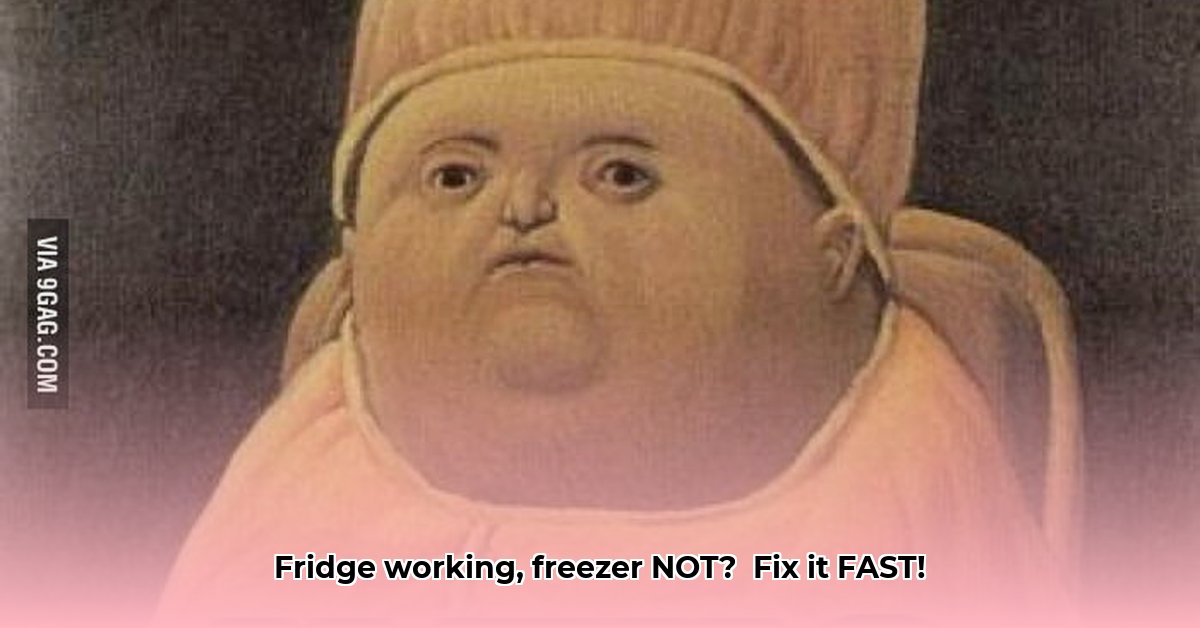Refrigerator working fine, but your freezer’s a warm mess? Don’t panic! This is a common problem, and chances are, we can fix it together. This guide will walk you through simple steps to troubleshoot why your freezer won’t freeze, even if your fridge is perfectly cold. We’ll cover everything from easy checks you can do yourself to when it’s time to call in the pros. For other appliance issues, check out our guide on [common appliance problems](https://turthledeep.com/water-heater-problems/). Get ready to get your freezer back to its icy best!
Why Is Refrigerator Working But Freezer Not Freezing? Troubleshooting and Solutions
It’s frustrating when your fridge is chilling perfectly, but your freezer’s decided to take a vacation. Don’t panic! This is a common problem, and often, it’s an easy fix. Let’s troubleshoot this together and explore common freezer issues.
Decoding the Chill: Identifying the Culprits Behind Your Warm Freezer
Most of the time, a freezer that’s not freezing while the fridge is perfectly fine comes down to a few simple issues. Think of it like a central heating system with a poorly insulated room. The system works, but the room struggles to stay warm. Similarly, a partially blocked vent inside the freezer, dusty condenser coils at the back (acting as the fridge’s radiators), or a door seal that’s lost its grip can significantly impede cold air circulation. A faulty door seal, in fact, can hike your energy bill by as much as 20% due to wasted cooling.
However, sometimes, the problem lies deeper. The freezer’s thermostat, the temperature control dial, might be malfunctioning. Is it set correctly, or is it failing to accurately sense the freezer’s temperature? A malfunctioning thermostat fails to maintain the optimal temperature, disrupting the entire cooling process. Frost buildup, acting as an insulating blanket, is another common culprit. This excess frost prevents efficient heat transfer, hindering the freezer’s performance. A clogged defrost drain can exacerbate this issue, leading to even more frost accumulation.
More complex issues might involve a failing compressor (the heart of the fridge), responsible for pumping the refrigerant that keeps things cold. A struggling compressor leads to an overall reduction in cooling system efficiency. Similar problems can arise from malfunctioning condenser coils (located on the back or bottom of the fridge, dissipating heat) or refrigerant leaks. Furthermore, components like dampers (regulating airflow) and thermistors (temperature sensors) can also malfunction, causing a range of cooling problems. A fully iced evaporator coil is another common reason your freezer stops to freeze.
Step-by-Step Troubleshooting: A Practical Guide to Reviving Your Freezer
Before calling a repair technician, let’s walk through some straightforward solutions. You might be surprised how often these simple steps resolve the issue.
Step 1: The Quick Checks
- Door Check: Ensure the freezer door is tightly closed and that it seals properly. Warm air intrusion is a primary cause of freezing inefficiency.
- Organization Check: Avoid overcrowding inside the freezer since it restrict airflow.
Step 2: Airflow Investigation
- Vent Check: Carefully examine the vents connecting the fridge and freezer compartments. Obstructions caused by food items or ice buildup can block airflow. Clear any obstructions immediately.
Step 3: Cleaning Duty
- Coil Cleaning: Locate the condenser coils (typically at the back or on the bottom of your fridge) and unplug the fridge. Use a coil brush and vacuum cleaner to gently remove accumulated dust and debris. This can significantly improve cooling efficiency.
Step 4: Drain Check
- Defrost Drain Check: Identify the defrost drain (refer to your fridge’s manual for its location). Ensure it’s not clogged with ice or debris. A clogged drain leads to frost buildup, impairing freezer performance. Clear with warm water.
Step 5: Temperature Check
- Temperature Setting: Double-check the freezer temperature setting. It should be set to 0°F (-18°C) or lower for optimal freezing. Ensure separate controls for the freezer and refrigerator are correctly adjusted.
Step 6: Listen Up!
- Compressor Sounds: Carefully listen to the compressor. Unusual humming or clicking noises indicate potential issues requiring professional attention. Inconsistent compressor operation is a red flag.
Step 7: Check the Evaporator Fan
- Open the freezer and listen for the evaporator fan. If you don’t hear it running, it may be stuck or broken.
When to Enlist the Pros: Recognizing When to Call for Fridge Repair Assistance
If your freezer remains inoperative after completing these steps, it’s time to contact a qualified refrigerator repair technician. Complex problems like refrigerant leaks or compressor failures require specialized tools and expertise. Attempting DIY repairs can be dangerous and may void your appliance warranty. Prioritize safety and ensure the longevity of your appliance by seeking professional assistance when needed.
Preventative Care: Proactive Steps to Maintain a Healthy Fridge
Regular maintenance ensures smooth fridge operation and extends its lifespan. Consider it an investment in your appliance’s long-term health.
- Regular Coil Cleaning: Clean condenser coils every few months, especially in dusty environments.
- Door Seal Inspection: Periodically inspect door seals for damage or wear. Replace worn seals promptly to maintain a tight seal.
- Frost Monitoring: Monitor frost buildup regularly. Excessive frost indicates potential issues with the defrost system requiring attention.
- Avoid Overstuffing: Avoid overloading your freezer to ensure proper airflow. Leave some empty space in your freezer.
- Check the temperature Regularly: Should be cold enough to freeze.
- Level the Refrigerator: Ensure that the refrigerator is level to prevent door-sealing problems.
Refrigerator Freezer Problems: A Troubleshooting Table
| Problem | Possible Solutions | When to Call a Pro |
|---|---|---|
| Blocked air vents | Remove obstructions. | Usually not needed |
| Dirty condenser coils | Clean with brush and vacuum. | Usually not needed |
| Faulty door seal | Replace worn seal. | Usually not needed |
| Excessive frost buildup | Check and clear defrost drain, manually defrost the freezer. | If defrost drain is consistently clogged or frost buildup is excessive. |
| Malfunctioning thermostat | Thermostat replacement. | Necessary |
| Compressor issues | Professional repair or replacement. | Necessary |
| Refrigerant leak | Professional repair and recharge. | Necessary |
| Defrost system malfunction | Professional inspection and repair of the defrost heater, defrost timer, or defrost thermostat. | Necessary |
| Faulty Evaporator Fan | Check the fan motor and replace if necessary | If you’re not comfortable with electrical repairs. |
| Iced Evaporator coil | Unplug the refrigerator and let the ice melt. Make sure the defrost drain is clear. | If the evaporator coil ices up repeatedly, there may be a problem with the defrost system. |
By following these steps and incorporating regular maintenance, you can keep your freezer freezing and your food fresh. Remember, professional help is always an option if you’re uncertain about any step. Have you considered the potential long-term cost savings associated with routine refrigerator maintenance?
How to Fix Refrigerator Working But Freezer Not Freezing: Effective Techniques
Key Takeaways:
- A warm freezer alongside a functioning fridge is a common and often resolvable issue.
- A systematic troubleshooting approach is essential, starting with basic checks.
- Various components (door seals, fans, defrost systems) can contribute to this problem.
- Professional intervention may be necessary for complex repairs.
Is Your Freezer More Like a Refrigerator? Quick Solutions
A non-freezing freezer is a kitchen emergency. Before you panic, recognize this is a common issue with often simple answers. Let’s identify the cause of the missing chill.
Step-by-Step Troubleshooting: Restoring Your Freezer’s Freeze
- Check the Obvious: Is your freezer overstuffed? Overcrowding restricts airflow, so create some space. Are vents blocked by food? Relocate those items.
- Temperature Check: Verify the temperature is correctly set. Modern refrigerators have digital displays for this. For older models, a manual adjustment might be needed.
- Door Seal Detective Work: Ensure freezer door seals fit tightly. Close the door on a piece of paper. If you can easily pull the paper out, replace the seals.
- Condenser Coil Clean-Up: Find the condenser coils (usually on the back or bottom). Dust reduces cooling efficiency. Unplug the refrigerator and clean the coils with a coil brush or vacuum.
- Evaporator Fan Test: Listen for the freezer fan. If it’s silent or sounds strange, replacement might be needed. Professional help may be required for this.
- Defrost Duty: Check for frost buildup. Excessive frost insulates and prevents cooling. Manual defrosting (unplugging and thawing) might be needed for older fridges. Automatic defrost issues require professional service.
- Thermostat Check: The thermostat regulates temperature. A faulty one causes inconsistent cooling. If other troubleshooting fails, the thermostat is a likely cause.
- When to Call for Backup
- Why an App Appeared on My Phone Unexpectedly - November 22, 2025
- How to Stop Unwanted Apps from Automatically Downloading on Android - November 21, 2025
- Why Are Android Games Installing Themselves on Your Phone? - November 20, 2025










